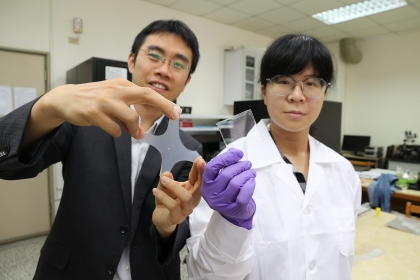NCHU Develops Electronic Skin: Self-Powering, Self-Healing, Transparent, and Superstretchable,
2019-08-06
興新聞張貼者
Unit秘書室
2,356
Ying-Chih Lai, an associate professor of the Department of Materials Science and Engineering at National Chung Hsing University, and his team have developed an electronic skin that is not only self-healable, superstretchable, and transparent but also able to operate via self-generating electricity.
The newly-designed electronic skin has great potential in robotics, prosthetic skins, smart electronics, and human-machine interfaces. The research results have been published in top international journal Advanced Functional Materials and has been selected as a VIP paper and cover story.
Professor Lai said that human skin is soft, stretchable, sensitive to the external environment, and self-healing after an injury while not being powered by batteries. The electronic skin was developed by simulating skin’s function, and the concept is derived from the Hollywood sci-fi movie franchise Terminator, in which Arnold Schwarzenegger portrays a self-repairing robot assassin. Utilizing special conductive electrodes and macromolecules as the basis, this newly invented electronic skin has functions such as stretchability, transparency, self-healing, and even self-powering without the need for a power supply.
Professor Lai indicated that artificial electronic skin is the focus of developments in robotics and human-machine interface technology. The current development bottleneck lies in the implementation of sensing elements on a large scale: the power consumption of a large number of passive sensors is the Achilles' heel of long-term use. In addition, breakdown and damage caused by external forces affect the lifespan of electronic skin.
This electronic skin is highly transparent, does not require a power supply, and is self-healable at ambient conditions. Not only is it smart, it is also energy-conserving and environmentally-friendly. The electronic skin has a transparency that reaches 88%, stretches more than 1000% of its own length. It can be adapted to different types of surfaces for integration and configuration. In addition to the application of novel power generation technology, this electronic skin can generate electricity which is inspired from the electric eel skin. With a power generation capacity of 20V and 240 μA/m2, a battery drive is not necessary for this new electronic skin. With the ability to actively operate on its own, the electricity generated can power small electronic products. Taking advantaging of its self-powering ability, this electronic skin can sense the external environment without additional power supply, solving the problem of power consumption by electronic skin.
The self-healing mechanism can be performed in room temperature without additional stimulation. The original components' function can be restored within two minutes, and the original shape can be restored within eight hours. After being lacerated by external forces for 500 times, the electronic skin can still self-heal.
Web-link of paper: https://doi.org/10.1002/adfm.201904626
The newly-designed electronic skin has great potential in robotics, prosthetic skins, smart electronics, and human-machine interfaces. The research results have been published in top international journal Advanced Functional Materials and has been selected as a VIP paper and cover story.
Professor Lai said that human skin is soft, stretchable, sensitive to the external environment, and self-healing after an injury while not being powered by batteries. The electronic skin was developed by simulating skin’s function, and the concept is derived from the Hollywood sci-fi movie franchise Terminator, in which Arnold Schwarzenegger portrays a self-repairing robot assassin. Utilizing special conductive electrodes and macromolecules as the basis, this newly invented electronic skin has functions such as stretchability, transparency, self-healing, and even self-powering without the need for a power supply.
Professor Lai indicated that artificial electronic skin is the focus of developments in robotics and human-machine interface technology. The current development bottleneck lies in the implementation of sensing elements on a large scale: the power consumption of a large number of passive sensors is the Achilles' heel of long-term use. In addition, breakdown and damage caused by external forces affect the lifespan of electronic skin.
This electronic skin is highly transparent, does not require a power supply, and is self-healable at ambient conditions. Not only is it smart, it is also energy-conserving and environmentally-friendly. The electronic skin has a transparency that reaches 88%, stretches more than 1000% of its own length. It can be adapted to different types of surfaces for integration and configuration. In addition to the application of novel power generation technology, this electronic skin can generate electricity which is inspired from the electric eel skin. With a power generation capacity of 20V and 240 μA/m2, a battery drive is not necessary for this new electronic skin. With the ability to actively operate on its own, the electricity generated can power small electronic products. Taking advantaging of its self-powering ability, this electronic skin can sense the external environment without additional power supply, solving the problem of power consumption by electronic skin.
The self-healing mechanism can be performed in room temperature without additional stimulation. The original components' function can be restored within two minutes, and the original shape can be restored within eight hours. After being lacerated by external forces for 500 times, the electronic skin can still self-heal.
Web-link of paper: https://doi.org/10.1002/adfm.201904626


